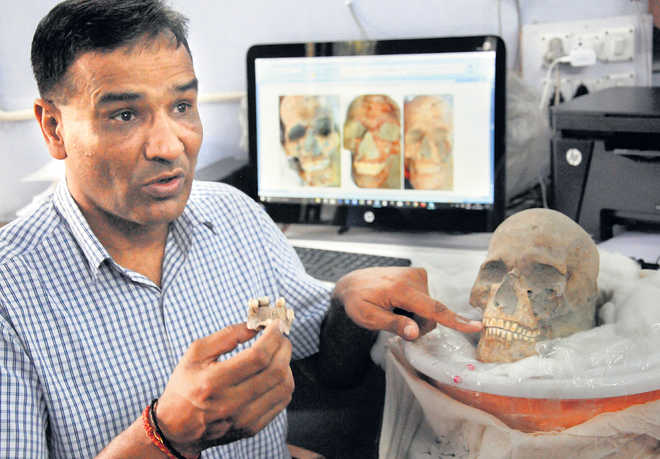Bhartesh Singh Thakur in Chandigarh
Sometime in 2014 Dr Jagminder Singh Sehrawat was busy explaining the nuances of forensics to his students of diploma at the anthropology department of Panjab University. He received a call from the Punjab government, telling him that a committee under then Punjabi University Vice Chancellor Jaspal Singh was looking for an expert in osteology —the study of skeletons — and odontology — the study of the structure of teeth and their diseases — to take up investigation of the skeletal remains of soldiers excavated from a well in Ajnala (Amritsar).
Historical evidence suggests the soldiers had mutinied against the British in 1857. They were executed — most shot in the head — and buried into a well on August 1, 1857.
The committee that chose Sehrawat had members from cultural affairs department of Punjab, forensic science laboratory, human genetics and Archaeological Survey of India.
A gurdwara had come up over the well over the years. But when a new building was raised, the Gurdwara Shaheed Gunj Management Committee decided to dig the well, known as ‘Kalianwala Khu’ (black people’s well). The digging started on February 28, 2014, and went on till March 2. When Sehrawat was called in, the unscientific digging was almost over. He consulted his mentor, Prof RK Pathak, of PU and both decided to take up the project.
“In India, such a large-scale study has never been carried out,” says Sehrawat.
‘It is in the tooth’
Sehrawat led a team of research scholars from his department. First he got the pieces of bones, which were intact, separated. His focus was on finding teeth of soldiers. “The whole information is in the tooth. We can know the age, gender, cause of death, nativity, migration pattern and even the caste of a person,” he says. He secured close to over 6,000 teeth in airtight boxes.
“About 36 intact skulls were recovered. Most of them have a bullet shot in the head. In some cases, the stone bullets are still embedded,” he says.
“We were left with only teeth and skulls,” he says. However, his team had managed to secure over 700 hand and foot remains, about 300 clavicle bones and over 600 parts of skulls and about 15 brain casts during their four-day visit to the site.
The Punjab government flatly told Sehrawat that no money would be paid. The PU, reeling under financial crisis, couldn’t support him. “Initially, I spent from my pocket. I was able to convince collaborators in Centre for Cellular and Microbial Biology (CCMB), Hyderabad, and Cranfield Forensic Institute, UK. But now, I have got a project from the Central government,” he says. “My findings are a tribute to those soldiers,” he says.
Science versus history
A historical account of execution of soldiers is available in a self-congratulatory book ‘The Crisis in the Punjab: From the 10th of May Until the Fall of Delhi written by Frederic Cooper, then deputy commissioner of Amritsar. But Sehrawat and his team are to prove or disprove it scientifically. “This project will end with personal identification of each remains which will include age, sex and cause of death,” says Prof RK Pathak, anthropology department, PU.
Preliminary anthropological analysis was concluded in early 2015 wherein shape, size, structure and other morphological features of available material were studied to know probable age, sex, ethnicity and trauma inflicted. To the surprise of Sehrawat and his team, the results suggested that there were some parts of women and children.
Sehrawat wrote to CCMB, Hyderabad, IIT-Roorkee, Cranfield Forensic Institute, Swindon (UK), SDM College of Dental and Medical Sciences, Dharwad (Karnataka) and Max Planck Institute of Human History, Germany, for collaborations to which they have agreed.
In 2016, elemental analysis of a sample of 200 molar teeth was conducted at PU in which elemental composition of 100 teeth of known identity were used to compare with the composition of teeth from Ajnala assemblage. “It indicated that 81% teeth were from males and 19% females,” said Monika, a research scholar at anthropology department at PU. The same year, Sehrawat got preliminary DNA results from a randomly selected sample of about 100 molar teeth. The preliminary advanced DNA studies have found that the victims belonged to the geographical regions as mentioned by Cooper in his book (1858), i.e. Bihar, UP and West Bengal,” he says.
The analysis has revealed that the number of soldiers was 200-246, which is at variance with the account of Cooper who gave the number 282. “Either he has overstated the figure or we have lost the remains during unscientific excavations,” says Sehrawat.
“The estimated cost for a single tooth’s analysis with full genome sequencing is more than Rs 70,000. And we have more than 6,000 human teeth retrieved from the assemblage at Ajnala,” says Sehrawat.
Unlock Exclusive Insights with The Tribune Premium
Take your experience further with Premium access.
Thought-provoking Opinions, Expert Analysis, In-depth Insights and other Member Only Benefits
Already a Member? Sign In Now











